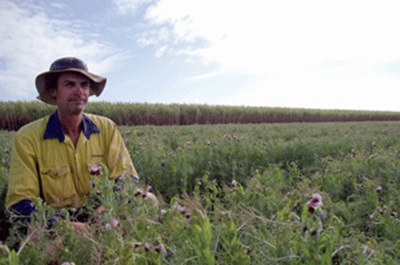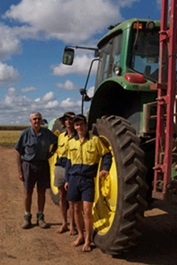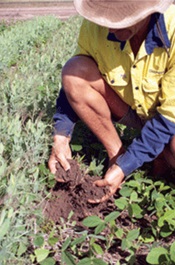Case Study
For many years, Tony and Katrina Chapman, along with son Mitchell and Tony’s father, Frank, have been implementing a controlled traffic, minimum tillage farming system that incorporates a legume crop in rotation with cane on their Bundaberg farm. Until fairly recently, soybeans and peanuts have been their legumes of choice but after a few years of field testing, Tony has found that he can also successfully grow field peas in winter.
When looking for another break crop option, Tony had three main criteria. The new crop needed to be a legume, to grow in winter and not be a weed in cane. He also hoped to find a crop that would provide an economic return.
His research led him to field peas, which are generally considered a crop suited to more temperate regions and are grown extensively in southern NSW and Victoria.
“We didn’t really know what to expect and those who had experience with field peas were not sure if they would grow successfully this far north,” says Tony. “In 2008 we planted about 2 ha just to see if they would grow.”
The initial field trial was successful enough for the Chapmans to grow more the next year and they were able to harvest and sell the grain. After working with University of Sydney plant breeder Steve Moore and BGA Agri-services agronomist Simon Andreoli for a few seasons, Tony has developed a good understanding of the crop’s requirements in the Bundaberg area. With increased crop management knowledge Tony is now confident that each crop he plants will yield a harvestable crop.
“We try to have something growing in all the blocks, all year round,” says Tony. “This is good for the soil biology and reduces the risk of erosion. The residue of a field pea crop is very soft and breaks down quickly, which is important given the small window between harvest and planting the next cane crop.”
Tony usually grows a plant crop and three ratoons. Cane cut early in the season is often sprayed out, and a 1.2 m bed is zonal tilled to provide a seedbed for soybeans, which are planted in November or December, without disturbing the wheeltrack area. Field peas are direct drilled into the soybean stubble and after the peas are harvested in August, Tony plants cane again.

Tony Chapman uses field peas as a break crop on his Bundaberg cane farm.
Using legumes as a standard part of their farming system, the Chapmans have been able to reduce the nitrogen applied to plant cane to 80–120 units.
“The biggest difference we have noticed is the stability in production,” says Tony.
“We are not aiming for the highest production but we are looking for efficiency, sustainability and profitability. The production system we use aims to reduce inputs, making farming cheaper, while maximising profits and improving soil fertility.”
Timing of each phase of the crop rotation is critical and incorporating a new crop without much agronomic information for the region being available has presented some challenges. All of the ‘mistakes’ have been a useful part of the learning curve and have helped build up a significant knowledge base for winter legumes in coastal farming systems.
“Field peas are a low input, low return crop,” he says.
“They are worth growing just for their contribution to soil nitrogen, organic matter and surface protection. We sell the grain through Bean Growers Australia and also small quantities direct to local buyers.”
Helicoverpa control is important in field peas and Tony has found the biological controls are generally fairly effective. The larvae cause significant damage though, downgrading the grain quality, so harder chemical options are used if required, unless the crop is intended to be turned in as a green manure. Field peas are also susceptible to powdery mildew in the late stages of podfill so Tony chooses varieties such as Yarrum, Willana and Maki that have greater disease resistance.

Frank, Tony and Mitchell Chapman on farm in Bundaberg.

Using legumes as a standard part of their farming system, the Chapmans have been able to reduce the nitrogen applied to plant cane to 80–120 units.
